Life Begins
zygote
The single cell that is formed from the fusing of two gametes, a sperm and an ovum.
Every person starts life as a single cell, called a zygote. Each zygote is distinct from any other human cell ever created, yet that cell contains genes that have been passed down for hundreds of thousands of years. The first hours of development are a compelling example of both the universal and the unique characteristics of each human.
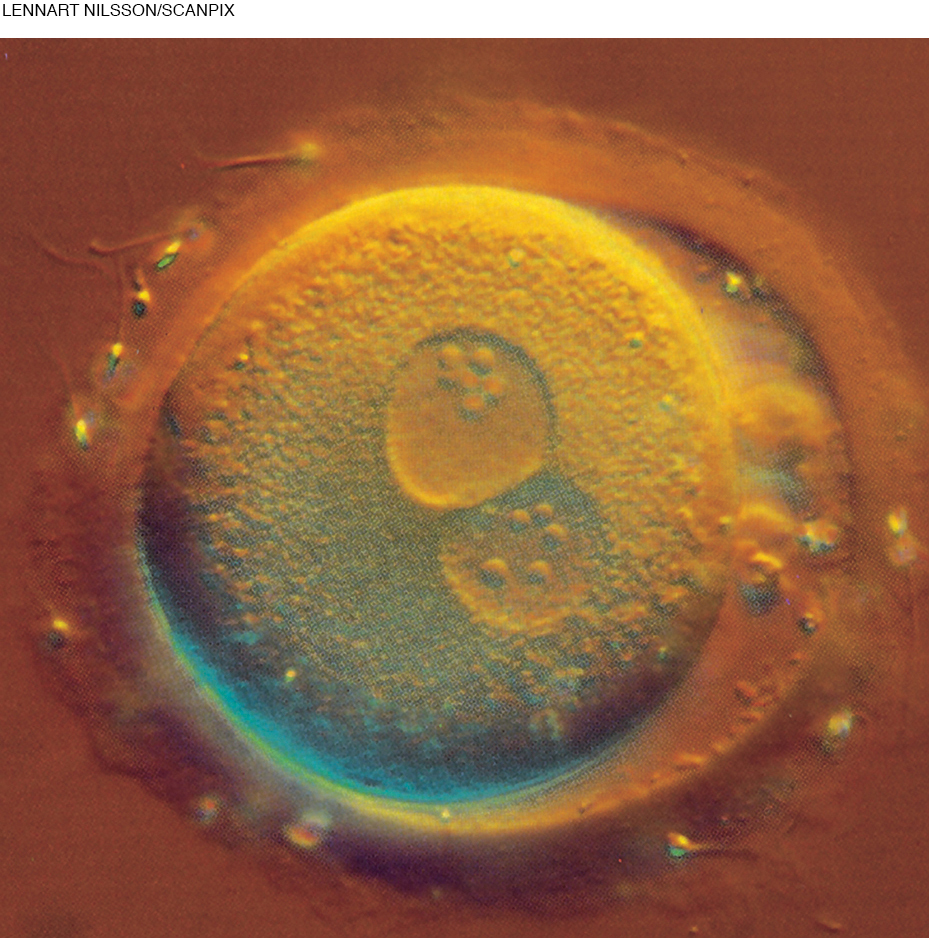
DNA (deoxyribonucleic acid)
The molecule that contains the chemical instructions for cells to manufacture various proteins.
chromosome
One of the 46 molecules of DNA (in 23 pairs) that each cell of the human body contains and that, together, contain all the genes. Other species have more or fewer chromosomes.
gene
A small section of a chromosome; the basic unit for the transmission of heredity. A gene consists of a string of chemicals that provide instructions for the cell to manufacture certain proteins.
Genes and Chromosomes
First, the universal. All living things are composed of cells that promote growth and sustain life according to instructions in their molecules of DNA (deoxyribonucleic acid) (see Figure 2.1). Each molecule of DNA is called a chromosome.Chromosomes contain units of instructions called genes,with each gene located on a particular chromosome.
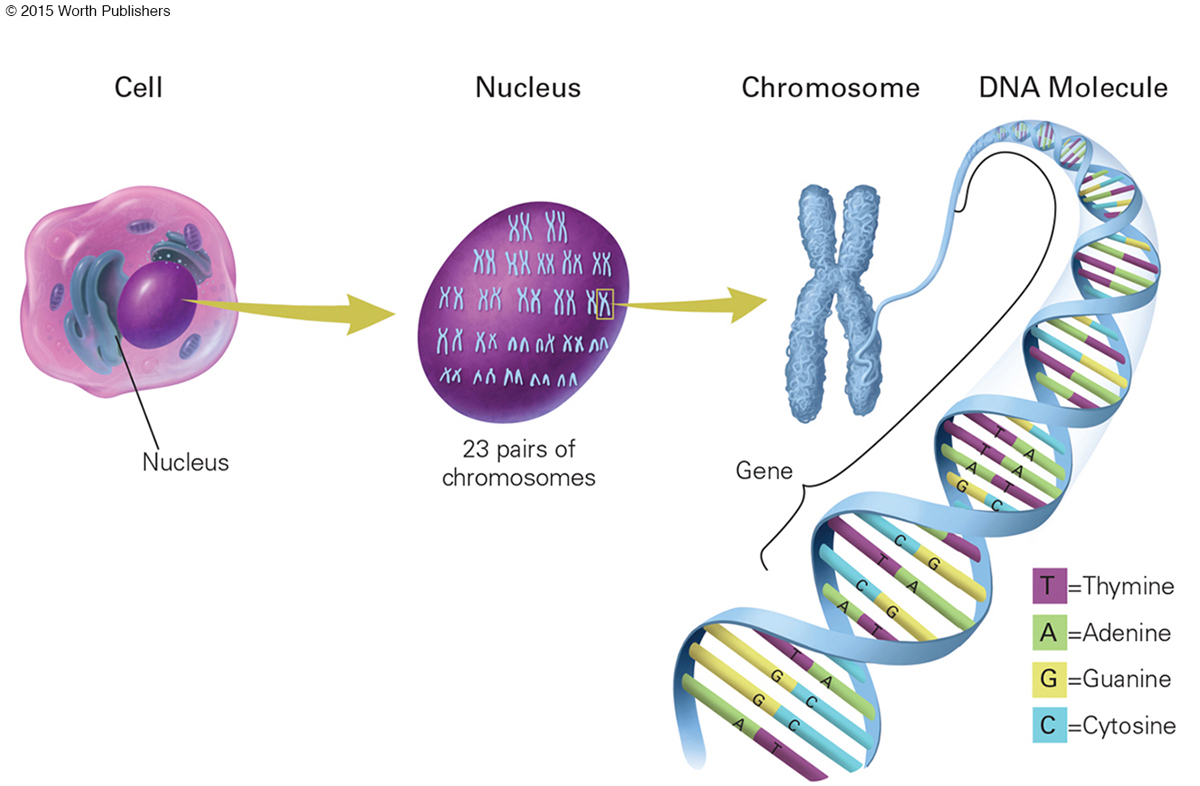
gamete
A reproductive cell; that is, a sperm or an ovum that can produce a new individual if it combines with a gamete from the other sex to form a zygote.
With one important exception, every cell of a normal human being has a copy of that person’s 46 chromosomes, arranged in 23 pairs. That one exception is the reproductive cell, called a gamete. Each gamete—
At conception, the genes on each of the 22 non-
If the match between the two genes is exact (as it usually is since most genes are identical for every human), the person is said to be homozygous (literally, “same zygote”) for that trait.
allele
Any of the possible forms of a gene. Genes with various alleles are called polymorphic.
However, some genes come in slightly different versions, as is obvious for eye-
Variations Among People
Now, the unique. Since each gamete has only 23 chromosomes (one from each pair of the parent’s 23 pairs), each man or woman can produce 223 different gametes—
When a sperm and an ovum combine, the zygote they create is a new cell in which the genes on one of 8 million possible sperm from the father interact with the genes on one of the 8 million possible ova from the mother. Your parents could have given you an astronomical number of siblings, each unique.
TRIPLET VARIATIONS More variations occur because the DNA code on those chromosomes contains about 3 billion pairs of chemicals organized in triplets (sets of three pairs), each of which specifies production of one of 20 possible amino acids. Those amino acids combine to produce proteins, and those proteins combine to produce a person. Small variations, mutations, or repetitions (called copy number variations) in the base pairs or triplets could make a notable difference in the proteins and thus, eventually, in the person.
And that is what happens. Some genes have triplet transpositions, deletions, or repetitions not found in other versions of the same gene. Not only do alleles affect the person, but also genes “are themselves transmitted to individual cells with large apparent mistakes—
NOT JUNK All these variations already make each person unique, but there is more. Additional DNA and RNA (another molecule) surround each gene. In a process called methylation, this material enhances, transcribes, connects, empowers, silences, regulates, and alters genes. This material used to be called junk—but no longer. As one team explains:
One of the most important discoveries in genetics in the last 10 years is that the vast majority of trait-
[Furey & Sethupathy, 2013, p. 705]
Pause for a moment to consider how significant this is. Obviously genes are crucial, but even more crucial is whether or not a gene is expressed. RNA turns some genes and alleles off. In other words, a person can have the genetic tendency for a particular trait, disease, or behavior, but that tendency might never appear in that person’s life because it was never turned on.
Think of turning on a lamp. Many elements must be in place before the room is illuminated. The lamp needs an unspent bulb screwed into the socket, a cord correctly plugged in, an electric bill paid, and an electricity source from the grid. Yet the room will be dark until the switch is flipped. That’s RNA.
Researchers who sought a single gene for, say, schizophrenia, or homosexuality, or even a tiny detail such as memory for chemistry formulas, have been disappointed. No such single genes exist. Instead, almost every trait arises from a combination of genes, each with a small potential impact, each dependent on epigenetic factors that determine whether that gene is expressed or silenced (Ayyanathan, 2014).
genotype
An organism’s entire genetic inheritance, or genetic potential.
GENOTYPE AND PHENOTYPE For each individual, the collection of his or her genes is called the genotype. It was once thought that the genotype led directly to facial characteristics, body formation, intelligence, personality, and so on, but this is much too simplistic.
phenotype
The observable characteristics of a person, including appearance, personality, intelligence, and all other apparent traits.
The phenotype,which is a person’s actual appearance and behavior, reflects much more than the genotype. The genotype is the beginning of diversity; the phenotype is the actual manifestation of it, the result of “multiple interactions among numerous genetic and environmental factors” (Nadeau & Dudley, 2011, p. 1015).
Diversity not only distinguishes each person (you can immediately spot a close friend in a crowd) but also allows adaptation. We are the only species that thrives on every continent, from the poles to the equator, eating blubber or locusts as the case may be.
One of the best parts of our adaptive genes is that we teach each other. If you or I suddenly found ourselves in a climate we had never experienced, we would quickly learn how to dress, where to sleep, and what to eat by observing people who had already adapted to that place. If our descendants stayed in the new place, eventually our great-
THINK CRITICALLY: You do not have some condition (perhaps addiction or asthma or anxiety) that troubles another member of your family. Do you credit genes or upbringing?
Thanks to our genetic diversity, even devastating diseases do not kill us all. For instance, a few people have alleles that defend them from HIV/AIDS (Aouizerat et al., 2011). Similarly, genotype differences allowed some of our ancestors to survive tuberculosis, malaria, the Black Death, and other scourges. In the most recent manifestation, a few people may have a genetic defense against Ebola, remaining healthy despite contact with body fluids from someone sick with that highly contagious virus (Rasmussen et al., 2014).
genome
The full set of genes that are the instructions to make an individual member of a certain species.
More on Shared and Divergent Genes
The entire packet of instructions that make a living organism is called the genome.There is a genome for every species, from Homo sapiens to the smallest insect, even for every kind of plant. A worldwide effort to map all the human genes led to the Human Genome Project, which was virtually completed in 2003.
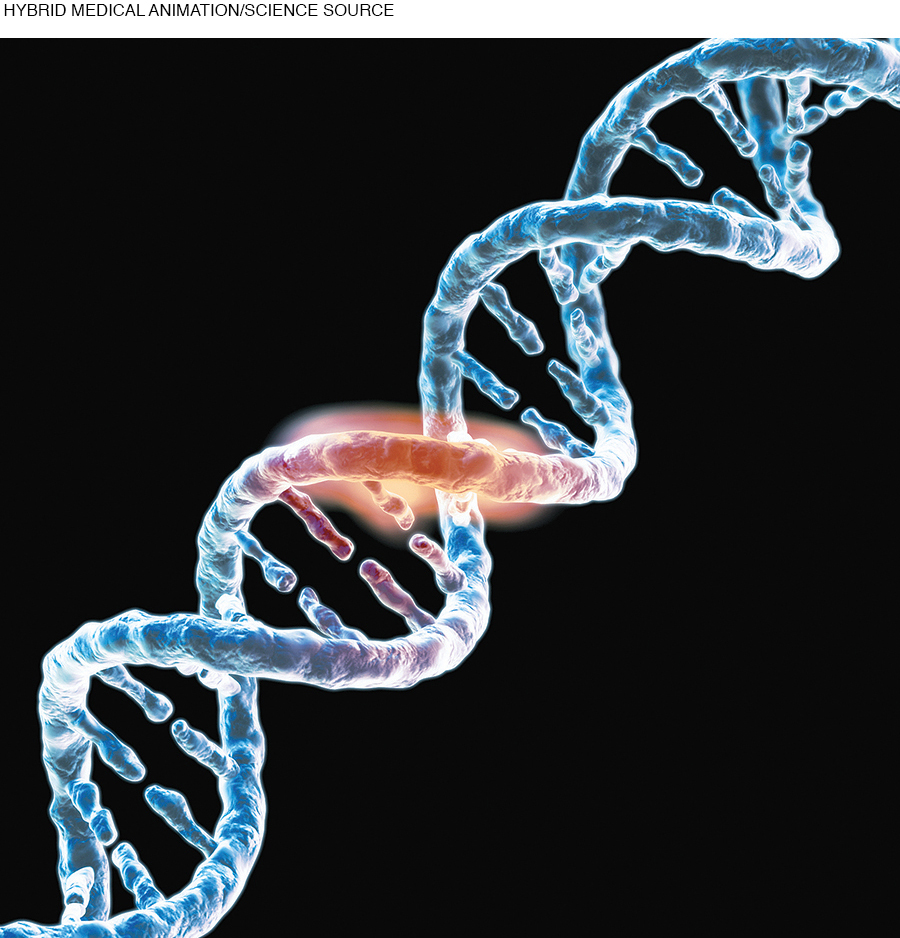
SURPRISES FROM THE HUMAN GENOME PROJECT Until 2001, scientists thought humans had about 100,000 genes, but that turned out to be a gross overestimate. The Human Genome Project found only about 20,000 to 23,000 genes.
Genomes from other creatures led to more surprises: Dogs and mice have more genes than humans, and mice have several times more. The precise count is still unknown, partly because of another surprise: It is not always clear where one gene ends and another begins.
Another surprise is that any two men or women, of whatever ethnicity, share 99.5 percent of their genetic codes. Not only are all humans much more alike than some thought, but also humans are much more similar to other mammals than most people imagined.
The genetic codes for humans and chimpanzees are 98 percent the same (although chimp genes are on 48, not 46, chromosomes), and the genomes for every other mammal are at least 90 percent the same as for people. All these shared genes allow scientists to learn about human genetics from other creatures, especially mice, by transposing, deactivating, enhancing, and duplicating their genes.
Although human similarities are astounding, differences that seem minor are significant, too. Some alleles are relatively common, detectable, and understood. For example, the apoE4 allele, unlike apoE2, renders a person more susceptible to AIDS, heart disease, and Alzheimer’s disease.
But many alleles have unknown effects, or perhaps no effects. And some polymorphisms are very rare: Each of us probably has one or two alleles that only one person in a million has. We have learned a lot about genes, and that makes us realize how much we do not know.
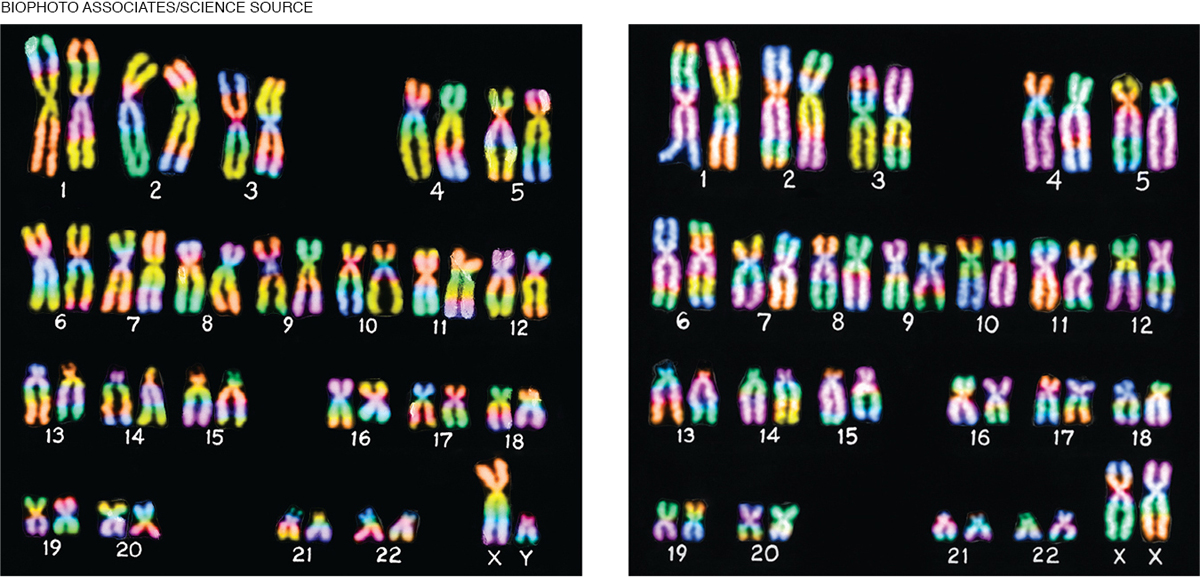
Research on breast cancer, for instance, has found two relatively common genes, named BRAC1 and BRAC2, that make it likely a woman will develop breast cancer if she lives long enough. Less than a fourth of the women who develop breast cancer carry one or the other of those genes. Perhaps another fourth have one of ten other known alleles that increase the risk, although how much and in what way is “ambiguous” (Kean, 2014, p. 1458).
That omits half of the millions (estimated at one woman in eight) who will develop breast cancer. Their disease is caused by a combination of genes, alleles, mutations, diet, and other epigenetic factors—
THE 23RD PAIR The difference between one person and another—
XX
A 23rd chromosome pair that consists of two X-
XY
A 23rd chromosome pair that consists of an X-
In females, the 23rd pair is composed of two large X-
Because a female’s 23rd pair is XX, every ovum contains one X or the other—
The Y chromosome has a gene (SRY) that directs the developing fetus to make male organs. Thus, the sex of the developing organism depends on which sperm penetrates the ovum—
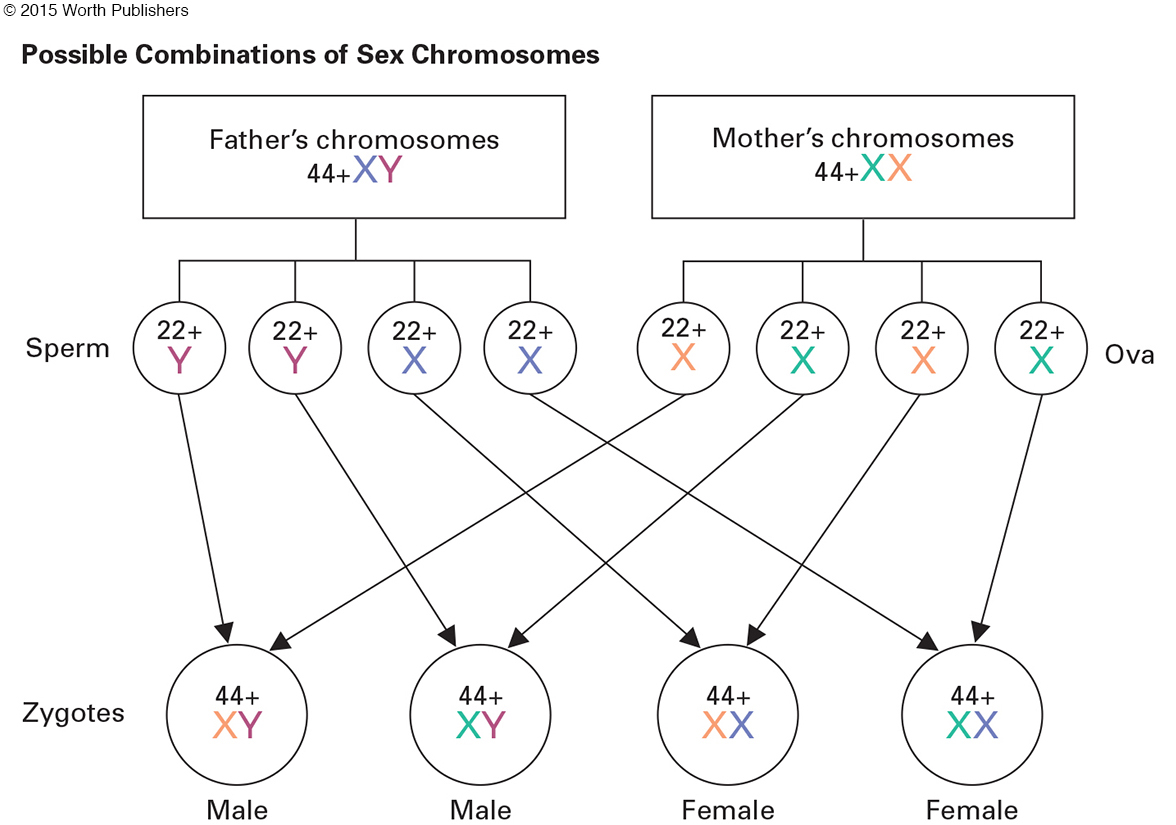
At conception, there are about 120 males for every 100 females, perhaps because Y sperm swim faster and reach the ovum first (remember, they carry fewer genes, so they are lighter than the X sperm).
However, male embryos are more vulnerable than female ones (because of fewer genes, again?), so they are less likely to survive prenatally: At birth the boy/girl ratio is about 104:100.
The sex ratio seems to be nature, not nurture, but the environment already has an effect. The United Nations reports that the natural sex ratio at birth in most developed nations (such as the United States) is 105:100, but it is lower in the poorest nations, probably because hunger and lack of prenatal care harms more male fetuses than female. In Angola, the ratio is 103:100 (United Nations, Department of Economic and Social Affairs, 2015).
Biological sex differences become cultural as soon as a newborn is named and wrapped in blue or pink. Indeed, cultural differences can begin before conception. Consider sex selection.
OPPOSING PERSPECTIVES
Too Many Boys?
In past centuries, millions of newborns were killed because they were the wrong sex, a practice that is considered murder today. Now the same goal is achieved in three ways: (1) by inactivating X or Y sperm before conception, (2) by inserting only the male or female zygotes after in vitro conception, or (3) by aborting XX or XY fetuses.
Should sex selection be illegal? It is, in at least 36 nations. It is not in the United States (Murray, 2014).
Why do some nations allow sex selection, and others not? Should governments legislate morals, or choose one culture over another? People disagree (Wilkinson, 2015).
One nation that forbids prenatal sex selection is China. This was not always so. In about 1979, China began a “one-
But advances in prenatal testing, and the Chinese tradition that sons, not daughters, must care for aged parents, led many couples to want their only child to be a boy. Among the unanticipated results: (1) since 1980 an estimated 9 million abortions of female fetuses; (2) between 1980 and 2006, adoption of an estimated 200,000 newborn girls by Westerners; (3) in 2010, far more unmarried young men than women.
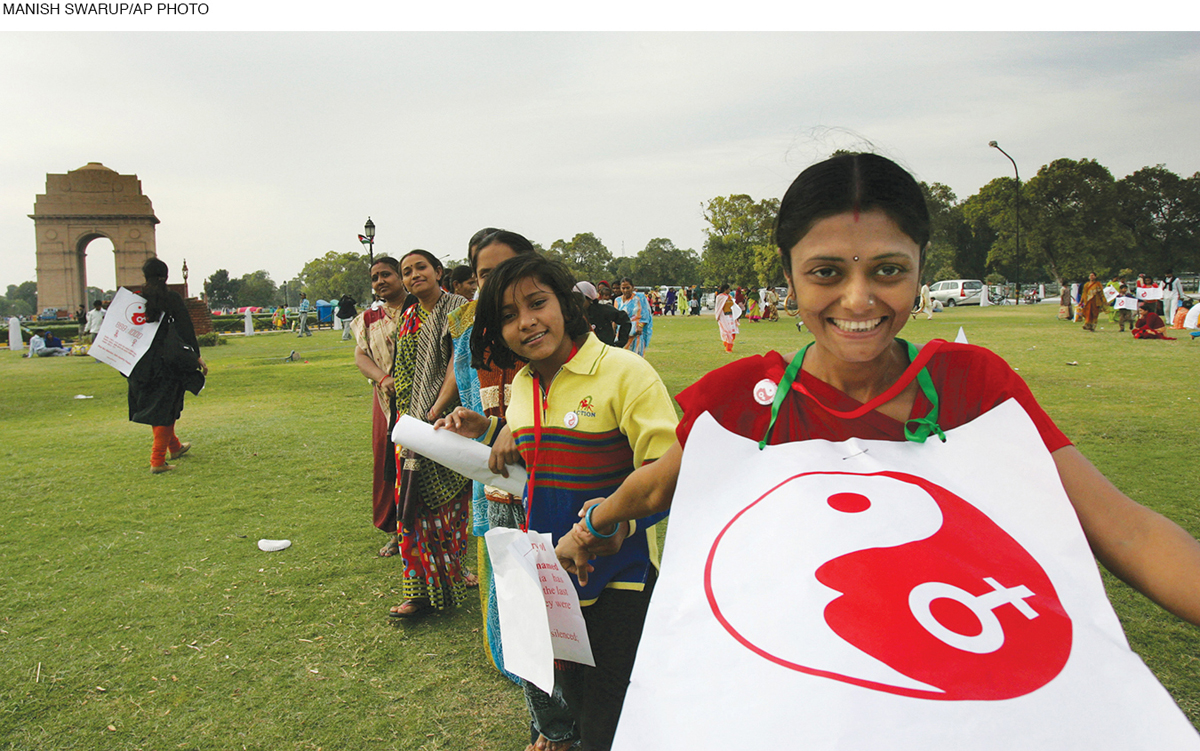
In 1993, the Chinese government forbade prenatal testing for sex selection. In 2007, China became much less likely to allow adoption, and the number of children from China adopted by Westerners plummeted from 14,496 in 2005 to 4,418 in 2011. In 2013, China rescinded the one-
Sex preferences are apparent everywhere. One elderly Indian man said, “We should have at least four children per family, three of them boys” (quoted in Khanna, 2010, p. 66). Couples of Asian ancestry in the United States also have more boys than girls (Puri et al., 2011). In some Western nations, including Germany, girls are preferred—
The argument in favor of sex selection is freedom from government interference. Some fertility doctors and many individuals believe that each couple should be able to decide how many children to have, and what sex they should be (Murray, 2014).
The argument against sex selection is that society might suffer. For instance, 30 years after the one-
Other problems may occur that affect a society that has many males. Males have higher rates than females of learning disabilities, drug addiction, suicide, homicide (as victims and killers), and heart attacks. They are more likely to vote for wars and advocate long sentences for criminals.
But wait: Genes do not determine behavior. Every sex difference is influenced by culture. Even traits that originate with biology, such as the propensity to heart attacks, are affected more by environment (in this case, diet and cigarettes) than by XX or XY chromosomes. Perhaps nurture would change if nature produced more males than females.
Already, medical measures and smoking reductions have reduced heart attacks in men. In the United States in 1950, among people under age 65, four times as many men as women died of heart disease. By 2010, the rate was lower for both sexes, but especially for men, 2:1 not 4:1. Lifelong, cardiovascular deaths are now close to sex-
Might laws against prenatal sex selection be unnecessary if culture shifted? “Might” . . . “if” . . . Critical thinking is needed; both opposing perspectives make sense.
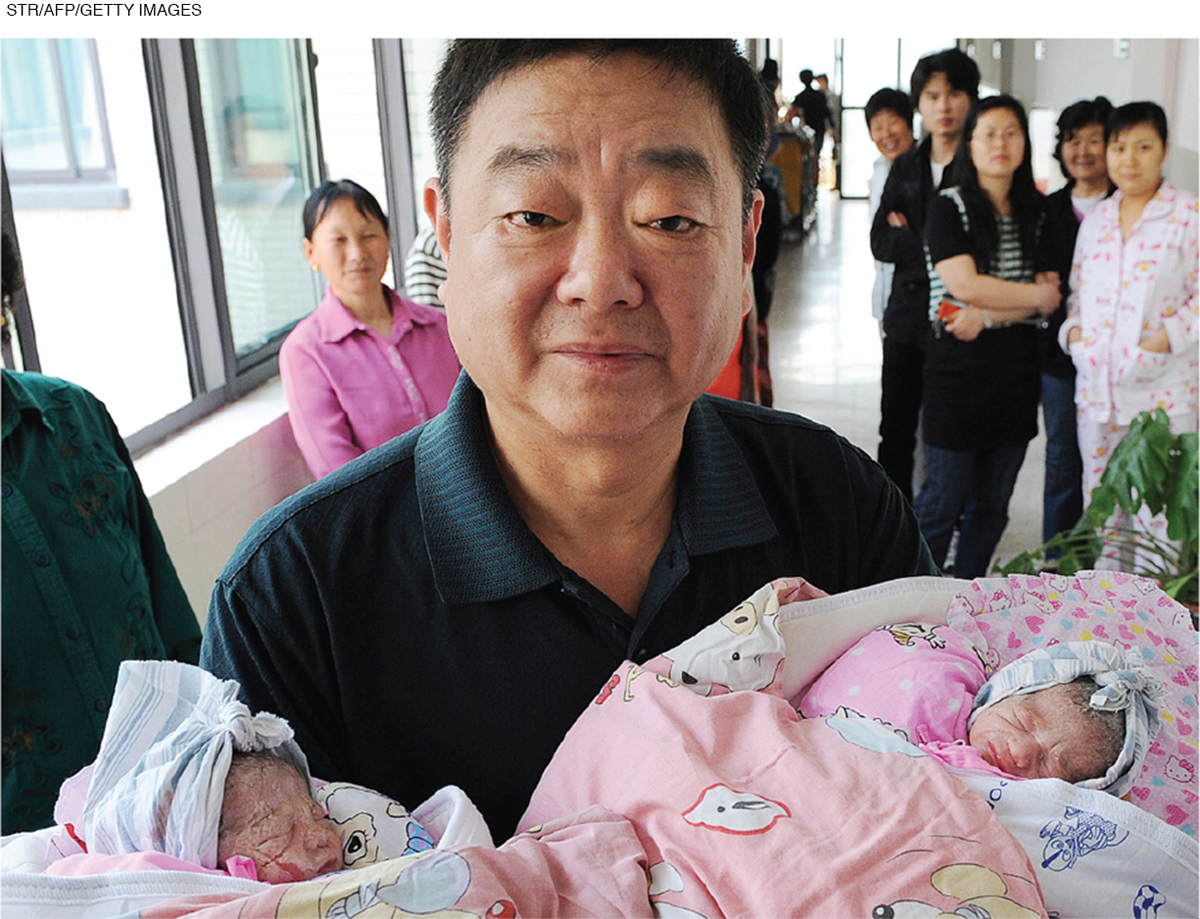
Twins
There is one major exception to genetic diversity. Although every zygote is genetically unique, not every newborn is.

Video Activity: Identical Twins: Growing Up Apart gives a real-
About once in every 250 human conceptions, the zygote not only duplicates but splits apart completely, creating two, or four, or even eight separate zygotes, each genetically identical to that first single cell (see Visualizing Development, page 54). If each separate cell implants and grows, multiple births occur, usually with every newborn genetically identical. This does not seem to be genetic, as the rate is similar—
monozygotic twins
Twins who originate from one zygote that splits apart very early in development. (Also called identical twins.)
One separation results in monozygotic twins, from one (mono) zygote. Two or three separations create monozygotic quadruplets or octuplets. (An incomplete split creates conjoined twins, formerly called Siamese twins.)
Because monozygotic multiples originate from the same zygote, they have virtually identical genetic instructions for physical appearance, psychological traits, vulnerability to diseases, and everything else. However, because nurture always affects nature, even before birth, identical twins do not have exactly the same phenotype.
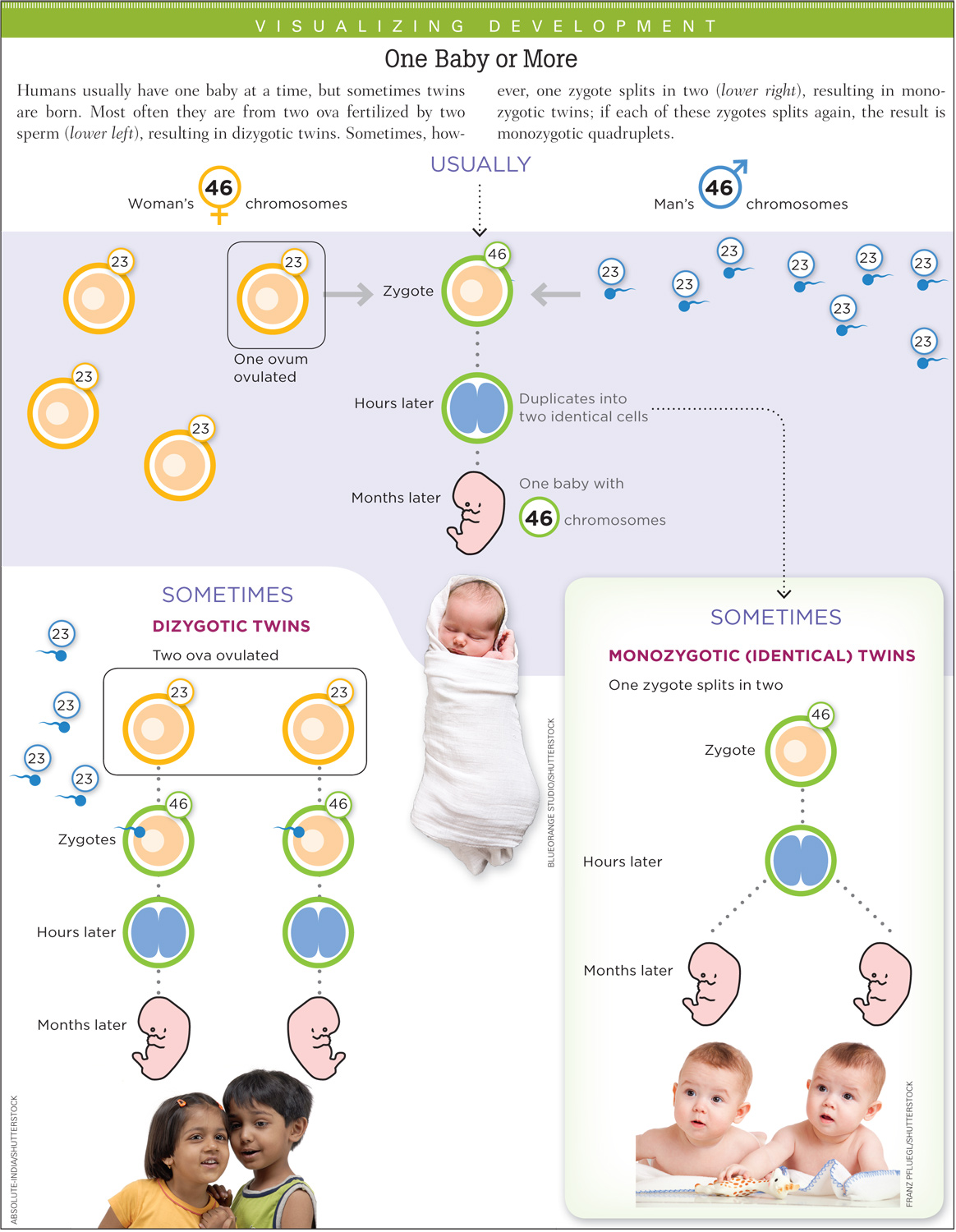
Usually, monozygotic twins develop their own identities while enjoying twinship. They might both have inherited athletic ability, for instance, but one chooses basketball and the other, soccer. One monozygotic twin writes:
Twins put into high relief the central challenge for all of us: self-
[Pogrebin, 2010, p. 9]
dizygotic twins
Twins who are formed when two separate ova are fertilized by two separate sperm at roughly the same time. (Also called fraternal twins.)
Dizygotic twins, also called fraternal twins, are born three times as often as monozygotic twins. They began life as two zygotes created by two ova fertilized by two sperm. (Usually, the ovaries release only one ovum per month, but sometimes two or more ova are released.) Dizygotic twins, like any offspring from the same two parents, have half their genes in common. Their phenotypes may differ (about half are male–
The incidence of multiple ovulation is influenced by genes, and thus is more common in some ethnic groups than others. For example, about 1 in 11 Yorubas in Nigeria is a twin, as are about 1 in 45 European Americans, 1 in 75 Japanese and Koreans, and 1 in 150 Chinese.
Age matters, too: Older women more often double-
Because genes endure lifelong, if a woman has one set of twins, she is more likely to have another set (Painter et al., 2010). Her daughters also have a 50/50 chance of inheriting her twin-
Genetic Interactions
No gene functions alone. Thus, almost every trait is polygenic (affected by many genes) and multifactorial (influenced by many factors). Almost daily, researchers describe new complexities in multifactorial interaction. Here we describe some of those complexities.
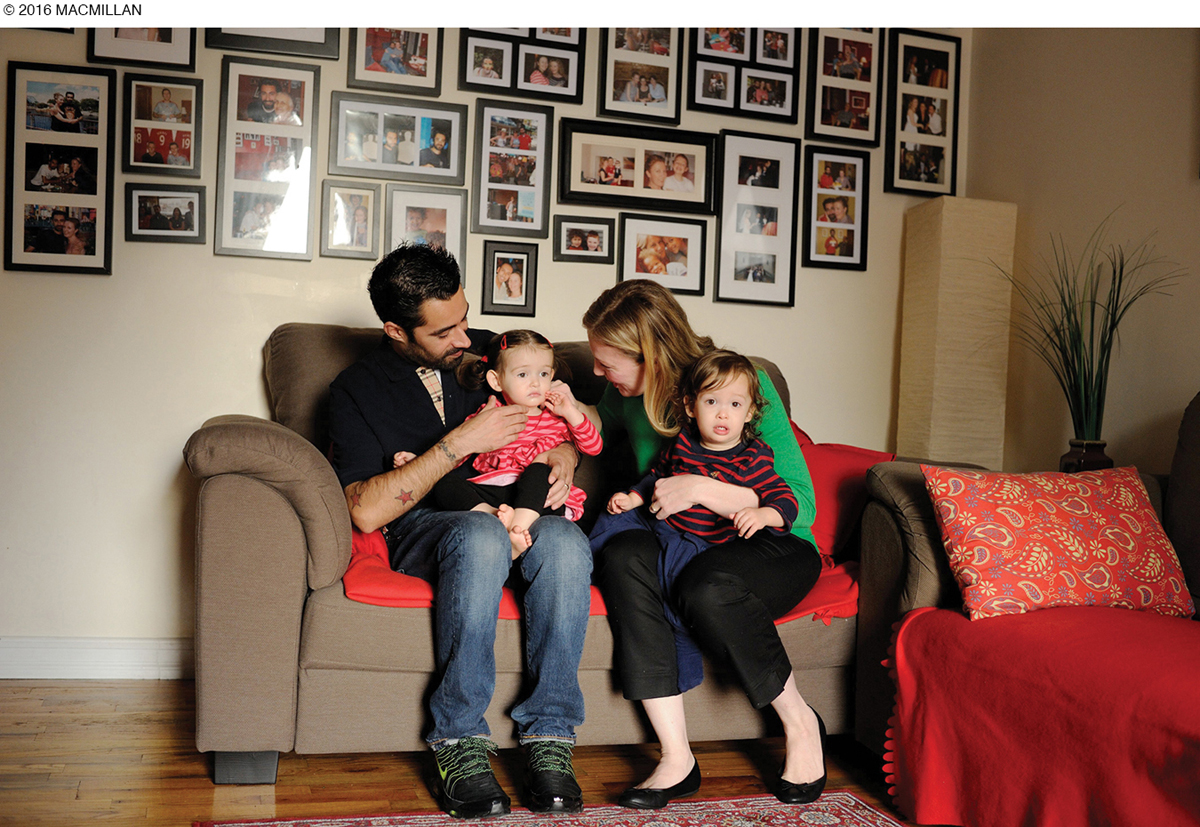
additive gene
A gene that adds something to some aspect of the phenotype. The full phenotype depends on additions from the other genes, which may come from either the same or the other parent.
Most genes are additive genes. Their effects add up to make the phenotype. When genes interact additively, the phenotype may reflect all the genes that are involved. Height, hair curliness, and skin color, for instance, are influenced by additive genes. Indeed, height is probably influenced by 180 genes, each contributing a very small amount (Enserink, 2011).
dominant–
The interaction of a pair of genes in such a way that the phenotype reveals the influence of one (the dominant gene) more than that of the other (the recessive gene).
carrier
A person whose genotype includes a gene that is not expressed in the phenotype. Such an unexpressed gene occurs in half the carrier’s gametes and thus is passed on to half the carrier’s children.
Less common are nonadditive genes, which do not contribute equal shares. In one nonadditive form of heredity, alleles interact in a dominant–
Most recessive genes are harmless. For example, blue eyes are determined by a recessive allele and brown eyes by a dominant one, which means that a child conceived by a blue-
“Usually” is accurate, because sometimes a brown-
Sometimes both parents are carriers. Then their children have one chance in four of inheriting the recessive gene from both parents. A blue-
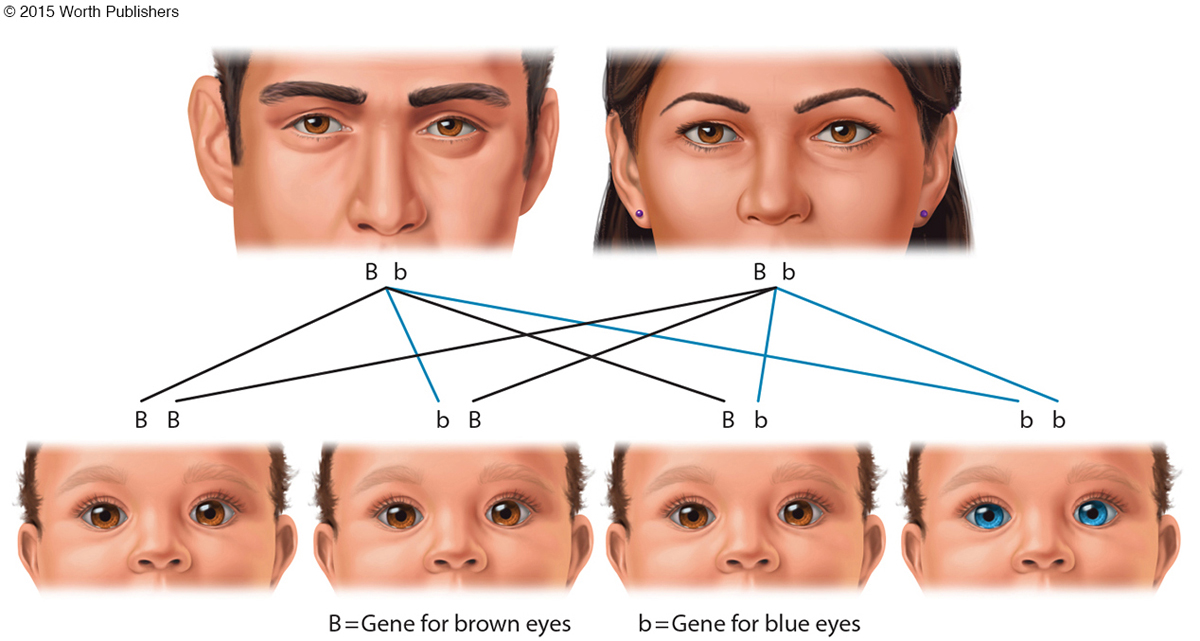
X-
A gene carried on the X chromosome. If a male inherits an X-
A special case of the dominant–
This follows from what you already know. Since the Y chromosome is much smaller than the X, an X-
This explains why males with an X-
| 23rd Pair | Phenotype | Genotype | Next Generation |
| 1. XX | Normal woman | Not a carrier | No color blindness from mother |
| 2. XY | Normal man | Normal X from mother | No color blindness from father |
| 3. XX | Normal woman | Carrier from father | Half her children will inherit her X. The girls with that X will be carriers; the boys with her X will be color- |
| 4. XX | Normal woman | Carrier from mother | Half her children will inherit her X. The girls with her X will be carriers; the boys with her X will be color- |
| 5. XY | Color- |
Inherited from mother | All his daughters will have his X. None of his sons will have his X. All his children will have normal vision, unless their mother also had an X for color blindness. |
| 6. XX | Color- |
Inherited from both parents | Every child will have one X from her. Therefore, every son will be color- |
Note: On this chart, the red X means that it contains the gene for color blindness.
Question 2.1
OBSERVATION QUIZ
Who has that genetic condition?
Ellie has a gene for achondroplasia, the most common form of dwarfism, which affects her limb growth, making her a little person. Because of her parents and her sister, she is likely to have a long and accomplished life: Her problems are less likely to come from her genotype than from how other people perceive her phenotype.

The final complexity is epigenetic, not solely genetic. All important human characteristics are influenced by nurture, including diseases known to be inherited, such as cancer, schizophrenia, and autism (Kundu, 2013; Plomin et al., 2013).
Diabetes is a notable example. People who inherit genes that put them at risk for type 2 (non-
One intervention—
The same may be true for other developmental changes over the life span. Drug use—
Some environmental factors that suppress or release genes are cognitive, not biological. For example, if a person feels lonely and rejected, that feeling can affect the RNA, which allows genetic potential for heart disease or social anxiety to be expressed (Slavich & Cole, 2013). Note that it is the feeling of loneliness, not the objective number of friends or social contacts, that has significant epigenetic influence.
WHAT HAVE YOU LEARNED?
Question 2.2
1. What is the relationship among DNA, chromosomes, and genes?
All living things are composed of cells that promote growth and sustain life according to instructions in their molecules of DNA. Each molecule of DNA is called a chromosome. Chromosomes contain units of instructions called genes, with each gene located on a particular chromosome.
Question 2.3
2. Why is it said that your parents could have given you millions of different siblings?
When a sperm and an ovum combine, the zygote they create is a new cell in which the genes on one of eight million possible sperm from the father interact with the genes on one of the eight million possible ova from the mother. This is how your parents could have given you an astronomical number of siblings, each unique.
Question 2.4
3. What surprises came from the Human Genome Project?
One of the surprises from the Human Genome Project was that humans have far fewer than 100,000 genes, the number everyone believed throughout the twentieth century. People actually have between 18,000 and 23,000 genes, fewer than dogs and mice. The project also found that it is not always clear where one gene ends and another begins, and any two men or women of any ethnicity share 99.5 percent of their genetic code.
Question 2.5
4. How is the sex of a zygote determined?
The sex of the zygote depends on which sperm penetrates the ovum—
Question 2.6
5. How do monozygotic twins, dizygotic twins, and nontwin siblings differ?
Monozygotic twins, also known as identical twins, originate from one zygote that splits apart very early in development; as a result, they have identical genetic makeup. Dizygotic twins, also called fraternal twins, are formed when two separate sperm fertilize two separate ova at roughly the same time. Like nontwin siblings, they share half of their genes and can look quite similar. The main difference between dizygotic twins and nontwin siblings is whether or not they are in utero at the same time.
Question 2.7
6. How could a child inherit a disease neither parent has?
If one of his parents is a carrier for that disease, he could inherit the disease. A carrier has a genotype that includes a gene that is not expressed in the phenotype. Such an unexpressed gene occurs in half the carrier’s gametes and therefore is passed on to half the carrier’s children.
Question 2.8
7. How is diabetes both genetic and not genetic?
Although people can inherit genes that put them at risk for type 2 (non-